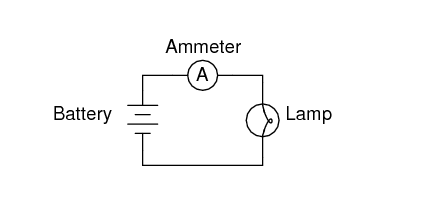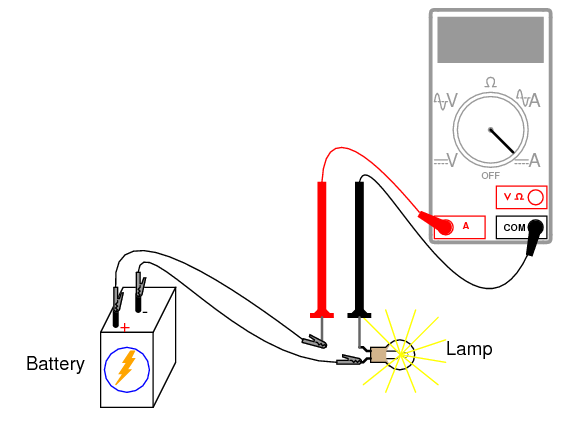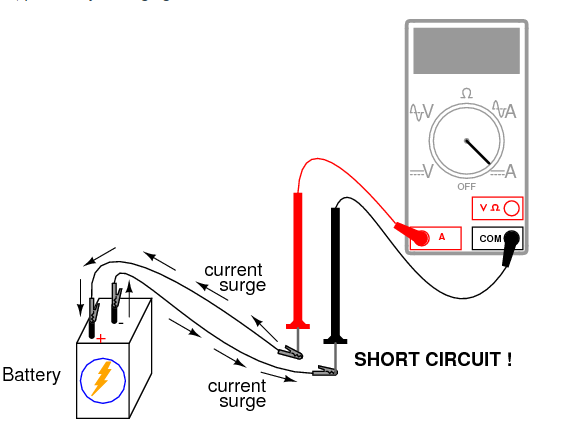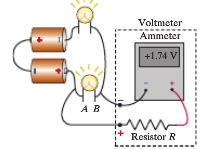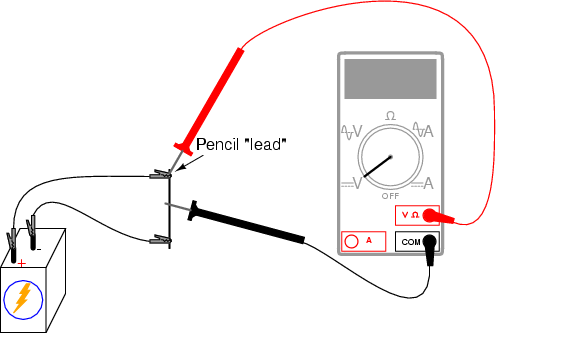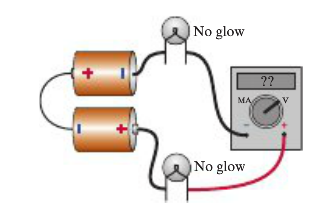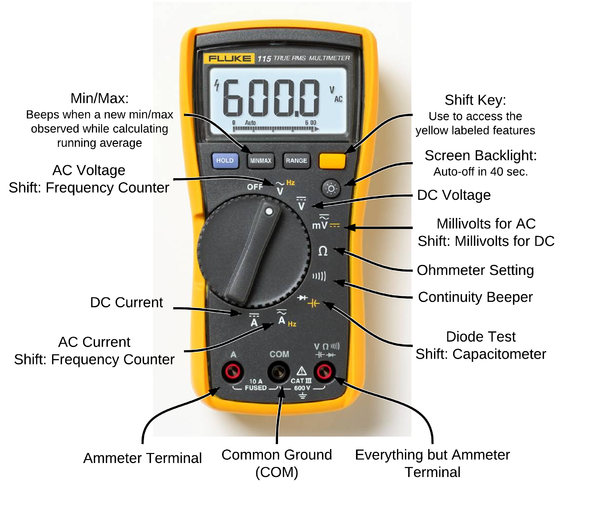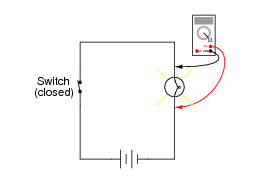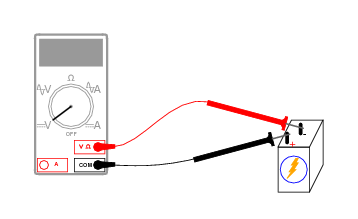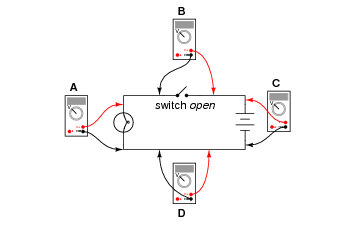Ammeters,Voltmeters,Ohmmeters
This page is created by jlukose6
This page will describe certain tools that are used in measuring various values inside of a circuit. Using these tools can help you calculate current, voltage, power and resistance across various circuits.
Ammeters
What is an Ammeter
An Ammeter is a measuring device used to measure the electric current in a circuit. It can be used in both series and parallel circuits. This is plausible through the very negligible resistance that the Ammeter introduces to the circuit. It allows us to measure the current running through a circuit element very closely. An Ammeter measures current in Amperes(A) named after Andre Marie Ampere.
Connecting Ammeters
To properly use Ammeters, they must be inserted into a circuit in series with the element that you want to measure. You bring the current into the + socket and out of the - socket. If a positive number is read then the conventional current is flowing into the + socket. Therefore, a negative number is read when conventional current flows into the - socket.
Ammeter in Parallel?
One rule of Ammeters is to have a low resistance so it doesn't alter the current through the circuit and the element that is being measured. So,what happens if you connect the Ammeter in parallel?
This would create an extremely low resistance path("short circuit"). All of the current would then pass through the Ammeter and the reading would be a measurement of the maximum current that the batteries(voltage source) can provide.
Voltmeters
What is a Voltmeter
A voltmeter is a measuring device used to measure the potential difference across two points in an electrical circuit. A Voltmeter is created by adding a series resistor (with resistance R) to an Ammeter and attaching this across an element. There is a measured current of I and the potential difference across the resistor is Va – Vb = RI. The ammeter is then relabeled and now measures Volts.
"Voltage is the measure of electrical “push” ready to motivate electrons to move through a conductor. In scientific terms, it is the specific energy per unit charge, mathematically defined as joules per coulomb. It is similar a to pressure in a fluid tube: the force that moves fluid through a pipe, and is measured in the unit of the Volt (V)."
Connecting Voltmeters
To measure the potential difference across two points, we need to attach the voltmeter in parallel to the two points. If the potential is higher at the + socket, the voltmeter indicates a positive potential difference. If the potential is higher at the – socket, the voltmeter indicates a negative potential difference.
Wrong Connections
Since the Voltmeter has a very large resistance, placing it in series throughout the circuit will cause a very large disturbance throughout the circuit. It would change the current running through the circuit drastically.However if the Voltmeter had low resistance and was placed in parallel, this causes a short circuit to occur.
Ohmmeters
What is an Ohmmeter
An Ohmmeter is a measuring device used to measure the Resistance of a resistor in an electrical circuit. They are created from Ammeters in series with a very small voltage source. When you connect to the unknown resistor, the small voltage pushes a current through the resistor and ammeter. The Ohmmeter is then "calibrated" to display the value of the applied voltage divided by observed current, R= V/I through Ohm's Law. Resistance is also measured in Ohms.
You will also notice that you have to remove the resistor of interest from the circuit before using this device because it is its own device with a voltage source.
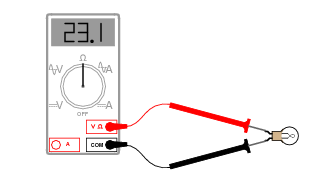
Commercial Meters
In reality, these devices are a little more efficient. Digital Voltmeters can read Voltage directly and they are made by testing how long it takes a known current to discharge a capacitor. A Digital Ammeter is a essentially a Voltmeter with a small resistance in parallel; it reads the small potential difference across the resistance. Digital Ohmmeters are created through driving a small known current through an unknown resistor and measuring the potential difference.
Multimeters
Usually all three of these devices can be meshed together to make one final measuring device. This device is often referred to as the Multimeter. It is also known as a VOM device because it can test Voltage, Resistance and Current. Some modern Multimeters can serve in the digital as well as analog level.
Examples
Simple
Question: How does is an Ohmmeter able to measure the resistance of a component when there is no source of power connected to this component? Why can't you use an Ohmmeter when a component is powered by a battery?
-We have to understand that Ohmmeters always contain a source of their own. They supply the component with a small current and test the difficulty of getting the current through.
- We can't use an Ohmmeter on the energized component because the voltage source of the component will interfere with the measurement of the Ohmmeter.
Question: Assume this battery has a voltage of 6 volts. What will the voltmeter read when it is connected to the battery like this?
- It will read a value of -6 Volts. This is because the negative lead is connected to the positive and the positive is connected to the negative.
Middling
Question:How do you find the resistance of an energized component in an electrical circuit? - Since you can't use the Ohmmeter, use your other tools such as the Voltmeter and Ammeter to measure the voltage and Current through this component. Using Ohm's Law, we can calculate for the resistance of the component.
Question: If you connect a voltmeter directly to an Ohmmeter, what do you expect to read on the Ohmmeter (resistance between the Voltmeter's test leads)? How about an Ammeter?
- We can expect to read a very high resistance. It is important to remember that Voltmeters have extremely high resistance.
-In the Ammeter, we can expect to see a very low resistance.
Difficult
Question: Determine the Voltage across the four Voltmeters(A,B,C,D) in the diagram
-Voltmeter A reads a Value of 0 Volts. The potential difference is 0 because the potential at both points is zero.
-Voltmeter B reads a value of 6 volts. The potential difference is 6 because on the right hand side the potential is 6 while on the left hand side, the potential is zero.
-Voltmeter C reads a value of 6 Volts. You can measure the voltage of the battery by connecting it in this way. You known that the potential on the positive side is 6 while negative side is 0.
-Voltmeter D reads a value of 0 Volts. The potential difference is 0 because the potential at both points is zero.
Connectedness
- How is it connected to your major?
I am a Computer Engineering(CompE)(both my major and something that interests me) student here at Georgia Institute of Technology. This is a topic that is extremely important to the world of ECE. We use these measuring devices in numerous real-life applications and building of circuits. They are a vital part to both teaching and understanding how a certain circuit performs.
- Is there an interesting industrial application?
Nowadays, most of these calculations are done computationally so there is no need for these physical measuring devices. However, some places still use these measuring devices in day to day life.
See also
Further reading
Electrical Instruments and Testing, How to Use the Voltmeter, Ohmmeter by Norman Hugh Schneider[1]
External links
What is an Ammeter?[[2]]
All About Circuits - Ohmmeters[[3]]
All About Circuits - Voltmeters[[4]]
All About Circuits - Ammeters[5]]
References
1. http://www.allaboutcircuits.com/textbook/experiments/chpt-2/ammeter-usage/
2. http://www.allaboutcircuits.com/textbook/experiments/chpt-2/voltage-usage/#
3. http://www.allaboutcircuits.com/textbook/experiments/chpt-2/ohmmeter-usage/#
4. http://study.com/academy/lesson/what-is-an-ammeter-definition-function-quiz.html
5. http://matterandinteractions.org/
6. Chabay, R.W; Sherwood, B.A.; Matter and Interactions. 2015. 4. 805-812.
